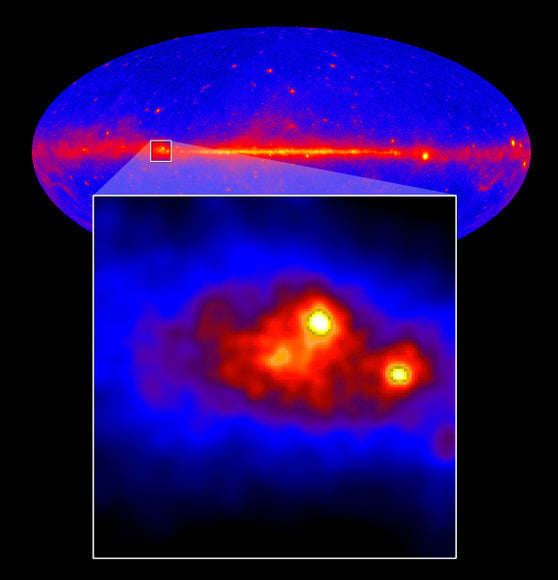Fermi's Large Area Telescope has detected bursts of gamma-rays in the binary system Cygnus X-3, which astronomers say are coming from a microquasar. While microquasars have strong emissions across is a broad range of wavelengths, this is the first time this type of object has been detected in gamma rays. "Cygnus X-3 is a genuine microquasar and it's the first for which we can prove high-energy gamma-ray emission," said Stéphane Corbel at Paris Diderot University in France.
[caption id="attachment_46154" align="aligncenter" width="580" caption="n Cygnus X-3, an accretion disk surrounding a black hole or neutron star orbits close to a hot, massive star. Gamma rays (purple, in this illustration) likely arise when fast-moving electrons above and below the disk collide with the star's ultraviolet light. Fermi sees more of this emission when the disk is on the far side of its orbit. Credit: NASA's Goddard Space Flight Center"]
[/caption] Microquasars are stellar mass object that displays in miniature some of the properties of quasars: a normal star begins shedding its matter onto either a neutron star or a black hole. This phenomenon produces large amounts of radiation and "jets" of material moving at relativistic speeds—more than 10% the speed of light—away from the star. These "relativistic jets" are a great mystery that astronomers are still trying to understand, but this new gamma-ray microquasar could provide new ways to study them.
At the center of Cygnus X-3 lies a massive Wolf-Rayet star. With a surface temperature of 100,255.372 Kelvin (180,000 degrees F,) or about 17 times hotter than the sun, the star is so hot that its mass bleeds into space in the form of a powerful outflow called a stellar wind. "In just 100,000 years, this fast, dense wind removes as much mass from the Wolf-Rayet star as our sun contains," said Robin Corbet at the University of Maryland, Baltimore County.
The researchers matched the gamma-rays to the known orbital period of the Cygnus X-3 microquasar in order to confirm that the strong pulses of radiation were, in fact, originating from the object. They also matched the gamma-rays with radio emission from the relativistic jets of Cygnus X-3. [caption id="attachment_46155" align="aligncenter" width="249" caption="Brighter colors indicate greater numbers of gamma rays detected in this Fermi LAT view of a region centered on the position of Cygnus X-3 (circled). The brightest sources are pulsars. Credit: NASA/DOE/Fermi LAT Collaboration"]
[/caption] Every 4.8 hours, a compact companion embedded in a disk of hot gas wheels around the star. "This object is most likely a black hole, but we can't yet rule out a neutron star," Corbet said.
Between Oct. 11 and Dec. 20, 2008, and again between June 8 and Aug. 2, 2009, Cygnus X-3 was unusually active. The team found that outbursts in the system's gamma-ray emission preceded flaring in the radio jet by roughly five days, strongly suggesting a relationship between the two.
These new findings should provide more information about the formation of such mysterious and fast-moving relativistic jets. This research appears in the 26 November issue of Science Express.
Read the team's abstract
Sources:
Science
,
Goddard Spaceflight Center
 Universe Today
Universe Today
